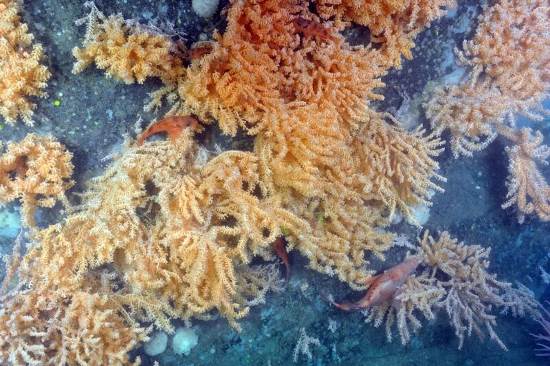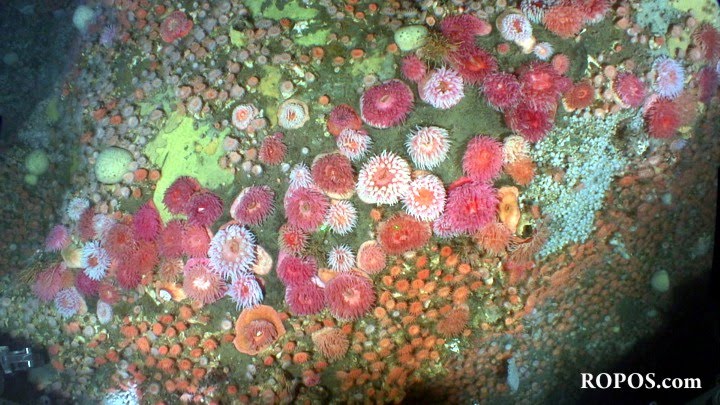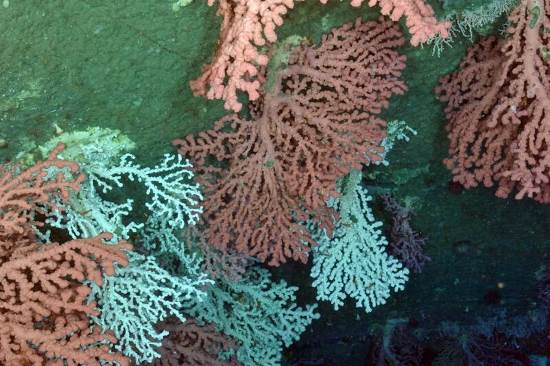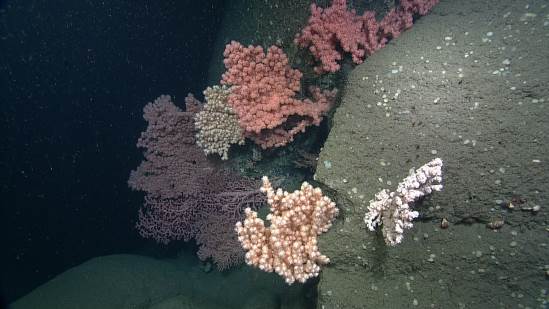Closures to Protect Sensitive Benthic Areas: Corsair/Georges Canyons and Eastern Jordan Basin
Fisheries and Oceans Canada (DFO) has taken steps to protect two areas of importance to cold water corals off Nova Scotia. A closure to bottom-contact fishing gear will be put in place in Corsair and Georges submarine canyons (off Georges Bank) and in an area of Jordan Basin (approximately 100 kilometres west of Yarmouth). These conservation measures amount to over 9000 square kilometres of offshore waters.
In June 2014, a research cruise conducted by Dalhousie University and the US National Oceanic and Atmospheric Administration (NOAA) in collaboration with DFO Science explored several areas of the Gulf of Maine. A video survey of the seafloor with a Remotely Operated Vehicle (ROV) was conducted and revealed significant cold water coral concentrations within Canadian waters.
Many species of cold water corals are sensitive to disturbance from human activities, including fishing gear designed to interact with the seafloor. Of particular conservation interest are the large, tree-like corals found in these areas, such as the “bubblegum coral” (Paragorgia arborea) and “seacorn” (Primnoa resedaeformis). They are long-lived, fragile and at risk of serious or irreversible harm from fishing or other human activity that comes into contact with the sea floor.
These coral communities qualify for protection under the Department’s Policy for Managing the Impact of Fishing on Sensitive Benthic Areas (SBA Policy). The purpose of the SBA Policy is to “mitigate the impacts of fishing on sensitive benthic areas or avoid impacts of fishing that are likely to cause serious or irreversible harm to sensitive marine habitat, communities and species”. The SBA Policy is the Department’s principal tool for meeting Canada’s commitment under the United Nations to identify and protect Vulnerable Marine Ecosystems (VMEs) in domestic waters. These protection efforts also support DFOs Coral & Sponge Conservation Strategy for Eastern Canada, released in 2015.
Closures in these areas will prohibit bottom-contact fishing, with the most active fisheries affected by these measures being lobster and red crab (trap) and groundfish (gillnet, longline and otter trawl). DFO will also work with other regulators and ocean users to minimize bottom disturbances in these areas.
The effort to protect these important areas began in the Fall of 2015, with discussions with the fishing industry and relevant advisory committees which included representatives from the Province of Nova Scotia. Comments received were taken into account in the selection of the final boundaries of these closures.
Details on the two areas are as follows:
These submarine or undersea canyons are located south of Georges Bank, near the Canadian-United States international border. These are large, steep sided and deep (over 2000 metres) valleys that cut into the seabed. These canyons are part of a chain found along the continental slope of eastern North America. Science surveys in 2014 in these areas documented high densities of gorgonian corals, such as “bubblegum” coral (Paragorgia arborea), and wide variety of other coral species, clinging to the walls of the canyon.
The area to be closed captures both canyons and extends along the slope edge (at approximately 300 metres depth) to the international border and also into deep waters out to the Exclusive Economic Zone boundary. Inclusion of the deeper portions is a precautionary action under the SBA Policy to protect other vulnerable deep-sea species and communities. Further exploration of the deep-sea communities in this area will help define and refine the closure over the next few years. In 2017, a joint Canada-US mission representing collaboration between Canadian academic researchers funded by NSERC, DFO, and NOAA, and, will continue the exploration of deep-sea ecosystems off Nova Scotia.
All bottom fishing will be prohibited in the closure; however two small “limited fishing” zones located next to Georges Canyon will allow red crab fishing. These zones are of particular importance to this fishery. Continued monitoring and future scientific surveys will assist DFO in evaluating the ongoing suitability of red crab fishing in these areas.
Sample Photos (Bubblegum coral – Paragorgia arborea Corsair Canyon)
Source: Anna Metaxas, Department of Oceanography, Dalhousie University; Martha Nizinski, NOAA/NMFS, USA; CSSF/ROPOS
Eastern Jordan Basin (the “Rock Garden”)
Several science surveys since 2005 have identified undersea features in the eastern portion of Jordan Basin as areas of conservation interest. The closure captures two prominent bedrock ridges and includes an outcrop originally called the “Rock Garden” when discovered by scientists. These features contain high densities of seacorn corals (Primnoa resedaeformis) and other sensitive filter feeding invertebrate communities. These structural habitats are important to other species such as groundfish, some of which are commercially harvested.

Source: Anna Metaxas, Department of Oceanography, Dalhousie University; Martha Nizinski, NOAA/NMFS, USA; CSSF/ROPOS

Figure 2a: Sample Photos (Seacorn coral - Primnoa resedaeformis, Jordan Basin) and assemblage of coral and sponges occupying the bedrock ridges and “Rock Garden” of eastern Jordan Basin
There are a wide variety of species of cold-water corals and sponges found in the Maritimes Region. Many of these are ecologically important providing three dimensional habitat and support to many other marine organisms, including commercial species. Over the past 15 years, DFO has protected several other areas off Nova Scotia with significant or unique coral and sponge habitats, including:
- coral concentrations in the Northeast Channel (between Browns and Georges Banks) in 2002;
- a rare Lophelia reef off Banquereau in 2004,
- the Gully canyon in 2004;
- rare sponge (Vazella pourtalesi) concentrations around Emerald Basin (about 100 kilometres offshore of Halifax) in 2013.
The importance of corals and the efforts undertaken to study and protect them in Maritimes Region are described here: National Centre of Expertise - Cold-Water Corals and Sponge Reefs.
Further information on the Coral & Sponge Conservation Strategy for Eastern Canada is available here: http://www.dfo-mpo.gc.ca/oceans/publications/cs-ce/index-eng.html
Further information on the Policy for Managing the Impact of Fishing on Sensitive Benthic Areas is available here: http://www.dfo-mpo.gc.ca/reports-rapports/regs/sff-cpd/benthi-back-fiche-eng.htm
Further information on the impacts to deep-sea corals from fishing activity can be found at: http://www.dfo-mpo.gc.ca/csas-sccs/Publications/SAR-AS/2010/2010_041-eng.html (CSAS SAR - 2010/041)
- Date modified:


